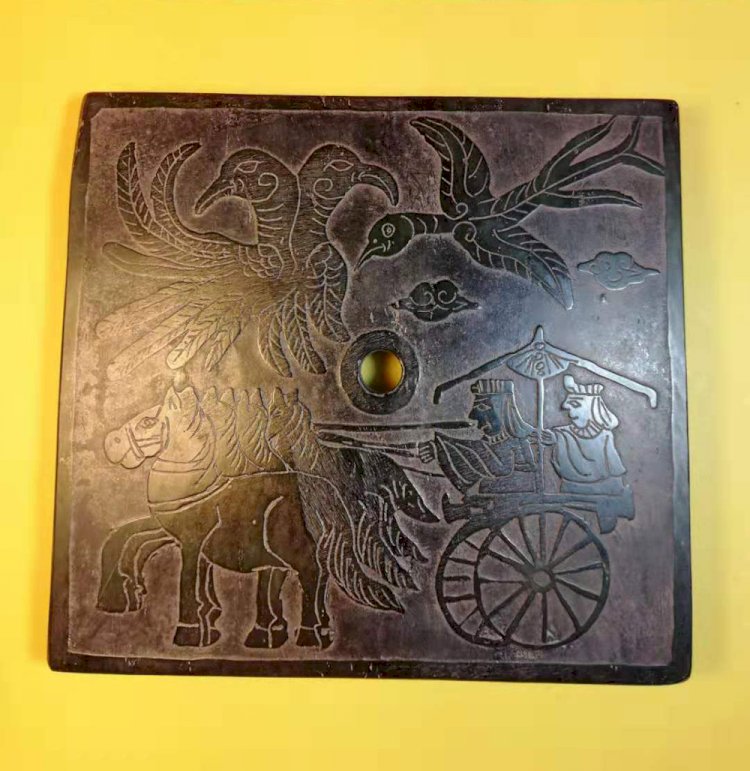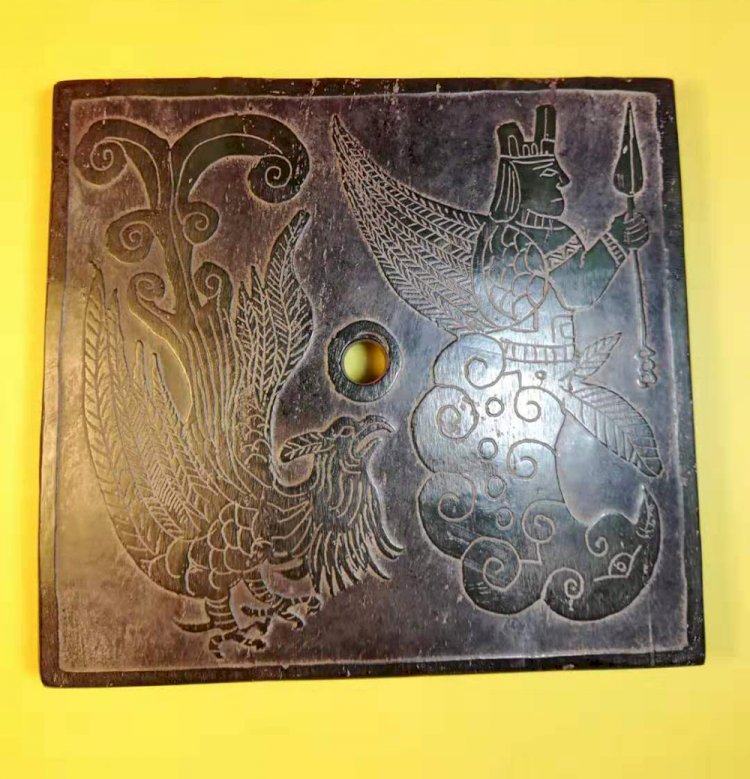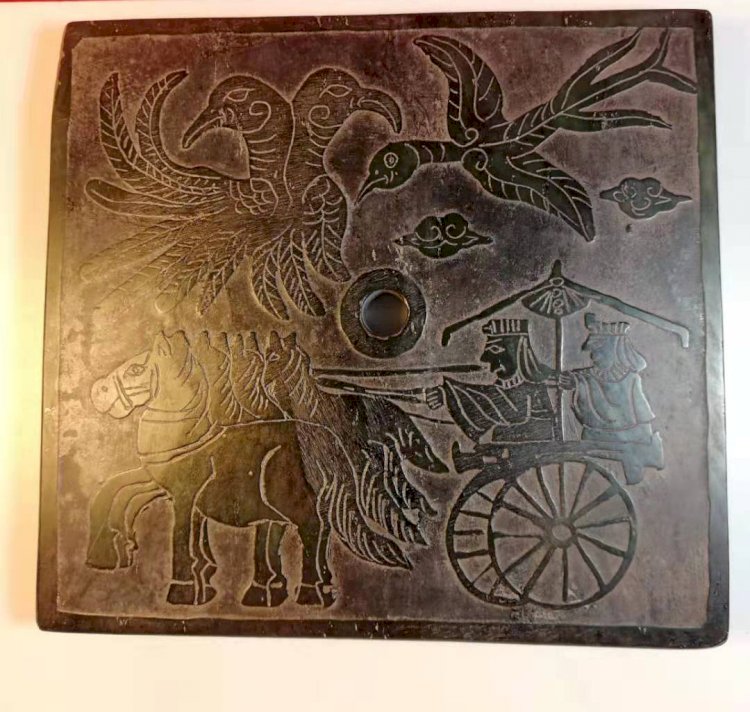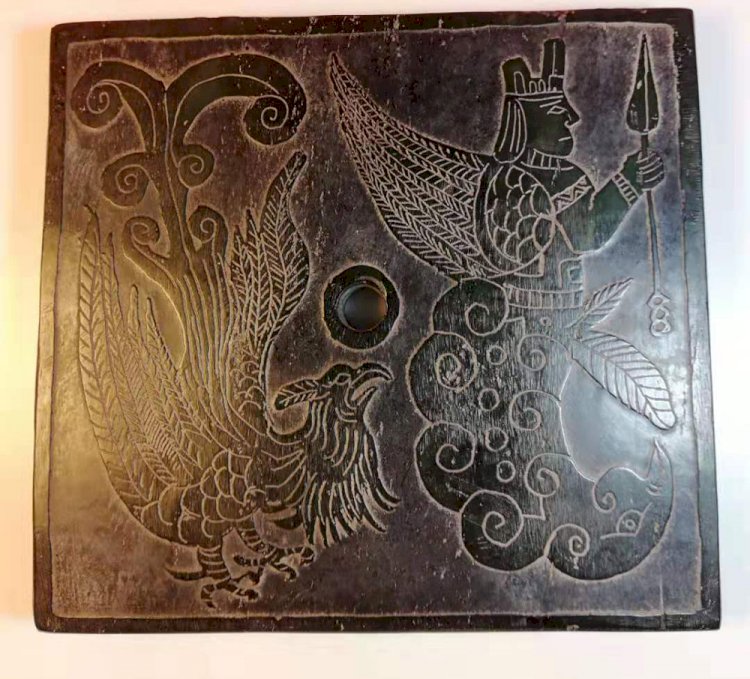G046 Square Bi Jade
Square Bi Jade of Han Dynasty
G046 Square Bi Jade of Han Dynasty
This square Bi jade: the length of each side is slightly different, can be viewed as high and wide. (Height: 11.70cm, width: 12.78cm, thickest: 1.55cm)
Green jade, with black paint erosion colour, there are round holes, light relief inside.
One side: there are three goshawks in the sky, and a carriage with two seats. No matter the sculpture of birds, figures, costumes and models, it is the style of the Han Dynasty. All these can be seen from the wall stone of the Wu's ancestral hall in Jiaxiang County, Shandong Province
Wu's ancestral hall is the hall for the family of Wu, a famous family in Rencheng. Its most famous are Wuliang ancestral hall and Wurong ancestral hall. Wuliang temple was built in the first year of Yongkang in the reign of emperor Huan of Han Dynasty, and its depiction was made by Lianggong Weigai. Wuling temple was built in the first year of Yongkang. Han Dynasty attaches great importance to gods and ghosts, so there are steles in the tomb, rooms in the ancestral hall, and the walls are carved with gods and ghosts, sages, people and animals for decoration. The portraits are all in relief, which is exactly the same as the shallow relief of the jade wall and its style.
For example, the three goshawks above the jade square wall are similar to the goshawks on one of the wall stones in the portraits of Wuliang temple. In the fourth layer, it is carved as the story of three Assassins: Cao foam, Zhuangzu and Jingke.” In "Warring States policy. Zhao policy", it is said: “Those officials who specialized in assassinating the emperor were like comets attacking the moon, like Nie Zhengzhi assassinating Han GUI, with swords like white rainbows running through the sun, and "Zhang Li's stab" Song Ji "was like a goshawk hitting the hall " It can be seen that from the spring and Autumn period and the Warring States period to the Han Dynasty, they all like to carve Eagles as decorations, or to enhance the atmosphere of their prestige, which has this meaning.
Another example: the carriage drawing of the jade square wall, the carriage drawing of the Han pictorial stone unearthed in yangzishan, Chengdu, Sichuan, and the carriage drawing of the Han pictorial brick unearthed in Chengdu. The style is very similar.
On the other side: a picture of a phoenix and a fairy like warrior is carved in a shallow relief of jade square.
In the Han Dynasty, Xu Shen said, "phoenix is the god bird.". Tianlao said: the image of the Phoenix, like the first half of the hung and the second half of the bunting, the snake neck and the tail of the fish, the Mandarin cheek of the stork catfish, the dragon pattern and the back of the tiger, the pecking of the swallow's chin chicken, all have five characteristics. It comes from the kingdom of the Oriental gentleman, flying all over the world, over Kunlun Mountain, drinking the mainstay, washing the feather and weak water, and staying in the wind cave in the evening. Seeing makes the world peaceful. "
Although there are some rambling words above, the phoenix patterns carved by the jade square Bi are just like the fish tail (referring to the difference between the phoenix tail), the chicken pecking with the swallow's chin and the five colors (referring to the beautiful feathers), which are consistent with the Phoenix in the imagination of the Han people, especially the so-called fish tail, which is more prominent. This jade phoenix pattern is different from the pattern phoenix pattern of Shang and Zhou dynasties. This phoenix pattern has become more realistic, which is also the expression of the style of Han Dynasty.
The spear holder on the right is a immortal warrior, whose lower body is in the shape of cirrus cloud and sharp tail, which can only be found in the stone carvings of Han Dynasty. In the wall stone of the portraits of Wuliang temple, one person is carved in the shape of cirrus cloud, which is like the lower end of the jade Bi warrior and has a larger volume; in the other stone sculptures of Fuxi Nuwa in Wuliang temple, both Fuxi and Nuwa are human body, snake foot and sharp tail, with a strong mythological element. The lower part of the body of the warrior like immortal in the jade square is in the shape of cirrus cloud and pointed tail, which is exactly the combination of the two mentioned above in Wuliang Temple of Han Dynasty. The immortal warrior on the jade square Bi has wings in the upper body.
It's said in the external biography of Poem of Han : "Wuwei tigers have wings. They will fly into the city and choose people to eat. "The book of Mountains and Seas is the book with the most myths. It records that there are many beasts with wings that can fly. In the Han Dynasty stone carvings and lacquerware portraits, there are many winged immortals and winged beasts, whose purpose is to make an unusual appearance and have immortal spirit.
In the Han Dynasty, the concept of "ascending to immortality by feather" was very strong. It was almost originated from the rise of the dragon's maiden to immortality by the Chu people. However, in the Warring States period, the theological thought was greatly impacted, but in the Han Dynasty, it was reversed, and its theological thought overflowed, which can be said to be the recovery of the religious aesthetic idea that within jades of Han Dynasty was similar to the jades of the Shang and Zhou dynasties.
The appearance of this rare square jade shows that jade in Han Dynasty is also thick, and simple, and has some primitive favour. This extremely rare jade carving pattern can be said to be unprecedented and unparalleled! The emergence of this precious material object, no matter in the study of the characteristics of the Han Dynasty, religious beliefs, sculpture art, is of great historical significance and value!!
































